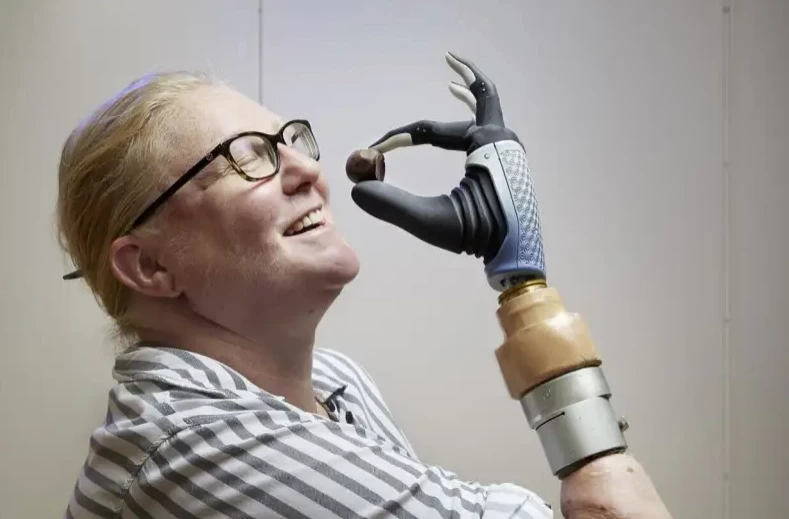The world is edging closer to creating fully functional prosthetic limbs, with the first clinical bionic attachment connected directly to the nervous and skeletal systems, plus artificial intelligence, restoring around 80% of daily use to the user’s hand and fingers.
Led by Professor Max Ortiz-Catalan, head of neural prosthetics research at Australia’s Bionics Institute in Australia, a massive team of engineers and surgeons across the globe have developed a new kind of prosthetic-body integration, which has provided Swedish amputee patient Karin with a limb almost as functional as the hand she lost in a farming accident. What’s more, it’s held up to constant daily use for more than three years.
“Karin was the first person with below-elbow amputation who received this new concept of a highly integrated bionic hand that can be used independently and reliably in daily life,” said Ortiz-Catalan. “The fact that she has been able to use her prosthesis comfortably and effectively in daily activities for years is a promising testament to the potential life-changing capabilities of this novel technology for individuals facing limb loss.”
Attachment and user control of prosthetic limbs remain two huge hurdles in this field of medicine. In an effort to combat these common issues, researchers developed a human-machine interface that would comfortably attach the artificial structure to the patient’s skeleton through the process of osseointegration. Then, electrodes implanted in nerves and muscles could also be attached to tap into the body’s nervous system.
Osseointegration is the direct structural and functional link between the patient’s living bone and the artificial implant – in this case, the bionic limb structure made of titanium. It was a complex procedure, requiring both the radius and ulna to be aligned and loaded with equal weight, limiting the space around it for other necessary components.
“The biological integration of titanium implants into bone tissue creates opportunities to further advance amputee care,” said Rickard Brånemark, associate professor at Gothenburg University and founder of biotech implants company Integrum. “By combining osseointegration with reconstructive surgery, implanted electrodes, and AI, we can restore human function in an unprecedented way. The below-elbow amputation level has particular challenges, and the level of functionality achieved marks an important milestone for the field of advanced extremity reconstructions as a whole.”
The research team were able to design a neuromusculoskeletal implant that could connect to the nervous system in the limited space the team had to work with around the two bone attachment sites.
“Karin is now using somewhat the same neural resources to control the prosthesis as she did for her missing biological hand,” said Ortiz-Catalan.

Karin then had her nerves and muscles repositioned by surgeons at Sahlgrenska University Hospital, so they could then provide optimal motor control information to the prosthetic.
“Depending on the clinical conditions, we can offer the best solution for our patients which sometimes is biological with a hand transplantation, and sometimes is bionic with neuromusculoskeletal prosthesis,” said Dr Paolo Sassu, who led the surgery. “We are continuously improving in both.”
As well as day-to-day tasks involving load-bearing and controlled movements such as holding full cups and using zips, it’s also significantly reduced the phantom pain – and subsequent pain medication – she’s faced since her accident nearly 20 years ago. Ongoing pain is one of the reasons many amputees give up on traditional prosthetic limbs.
“It felt like I constantly had my hand in a meat grinder, which created a high level of stress and I had to take high doses of various painkillers,” she said. “For me, this research has meant a lot, as it has given me a better life.”
The futuristic limb – known as Mia Hand, developed by Italian robotic hand prosthetics company Prensilia – features five grasps, one for each finger, and promises to provide 80% of daily movements. The results of the three-year study on Mia Hand integration signals a huge step forward in the development of replacement limbs that can be used comfortably and functionally in daily life.
The research was published in the journal Science Robotics.
See the video below for how this biotechnology feat was achieved.





